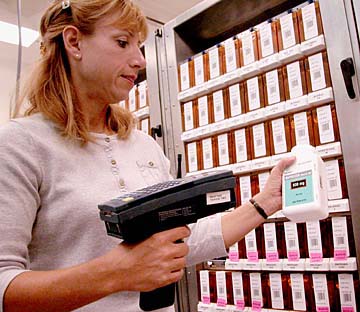
CRAIG T. KOJIMA / CKOJIMA@STARBULLETIN.COM
Stacy Kurt scans a bar-coded bottle of pills at Kaiser Permanente's Automated Refill Center.
Reducing drug errors Some Hawaii hospitals in the next few years expect to have bar codes on patients' wristbands to be cross-checked with bar-coded medications prescribed by their doctors.
FDA-proposed bar codes on
medicine should help hospitals
protect their patientsBy Helen Altonn
haltonn@starbulletin.comThis is part of a movement across the country to reduce medical errors. The issue made headlines recently when a 17-year-old transplant patient died at Duke University Medical Center after doctors gave her organs of the wrong blood type.
Pharmacy managers at the Queen's Medical Center, Kaiser Permanente Hawaii and St. Francis Health Systems Liliha and West say pharmacists have been waiting for federal regulations ordering bar codes on all human drug and blood products.
They welcome a U.S. Food and Drug Administration rule proposed March 13 "because it will really put the onus on the manufacturers to bar-code their products," said Kurt Schanzenbach, who heads Queen's pharmacy services.
The medical industry was given 90 days to comment on the proposed rule, which requires manufacturers to have bar codes on all products within three years.
A bar code is a patterned set of vertical lines printed on items containing coded data that can be scanned and decoded by a computerized scanner.
Schanzenbach said the American Society of Health System Pharmacists has pushed a long time for a bar-coding program "to really help patients and the nurses at bedside to prevent a medication error."
Barbara Kashiwabara, Kaiser Permanente Hawaii pharmacy services director, said pharmacists are thrilled that the FDA has moved to require bar codes on all drugs "and standardize the bar-code methodology. Patient safety is our priority and this decision will go a long way towards that goal."
But just putting bar codes on drugs isn't enough, Schanzenbach said, explaining hospitals also must put bar codes on patient wristbands. They must be able to scan the patient and the medication and connect that information to a computer system with a record of medications ordered by the physician for the patient, he said.
"If it doesn't match -- the patient doesn't have an order for the drug or the drug is the wrong dose -- it will alert the nurse that something is wrong."
Bob Zolnierz, St. Francis director of pharmacy services, said the hospital bar-codes all tablets and capsules and puts them into an 8-by-8-foot computerized McKesson Robot.
Patients also have name tags produced with a bar code, linked with the pharmacy computer, he said. The robot has an arm that takes whatever medications are ordered by the computer for the patient and puts them in a cart, he said.
"It's not 100 percent," he said. "We're waiting for manufacturers to bar-code things like injections."
Kashiwabara said many drug manufacturers have voluntarily put bar codes on drugs, "which is evident on many bottles found in our Kaiser outpatient pharmacies."
Most of the bar codes have information required by the FDA decision -- an identifying number like a "drug social security number," a lot number and expiration date, she said, adding that this improves the accuracy and safety of the preparation and dispensing process.
At Kaiser's Automated Refill Center, which fills prescriptions for outpatient pharmacies and mailing to members, all drugs are bar-coded either by the manufacturer or the center, Kashiwabara said.
The center fills 1,800 to 2,000 prescriptions in eight hours "very accurately and very efficiently," with no drug selection errors to date, she said.
However, few drugs are bar-coded in the hospital's medication system, she said. "So this FDA decision will move us towards improvement in the accuracy of the drug selection process and enable bedside scanning of medications for patients."
Queen's and Kaiser are among hospitals working on computer software programming and hardware needed to implement the system.
Schanzenbach said the typical cost of implementation, depending on the hospital, will be about $1 million.
It's complex, he said, because bar-coded wristbands must interface with computer systems for laboratory use and blood transfusions. He estimates the project will take two to 2 1/2 years to complete at Queen's.
Under the current system, he said, a nurse has an administration record listing medications the patient is supposed to receive. The pharmacy sends the medications to the patient's floor and the nurse must compare them to the record and look at the patient's wrist band to make sure it's the right person.
"But it's all manual," he said. "The more you can reduce human error, the better."
Schanzenbach said the Veterans Affairs system is the best example. It adopted the bar-code system nationwide and has experienced a 70 percent to 80 percent decrease in medication errors, he said.
Besides improving patient safety, bar-coded medications result in savings, he said, noting the Institute of Medicine reported in 1999 that an adverse drug event costs $5,000.
Kashiwabara said a recent study at the University of Washington Hospital showed bedside bar code scanning of medications reduced medication administration errors by 68 percent.
"They equated bedside scanning of medications in the name of patient safety as important as seat belts are to passenger safety," she said.
